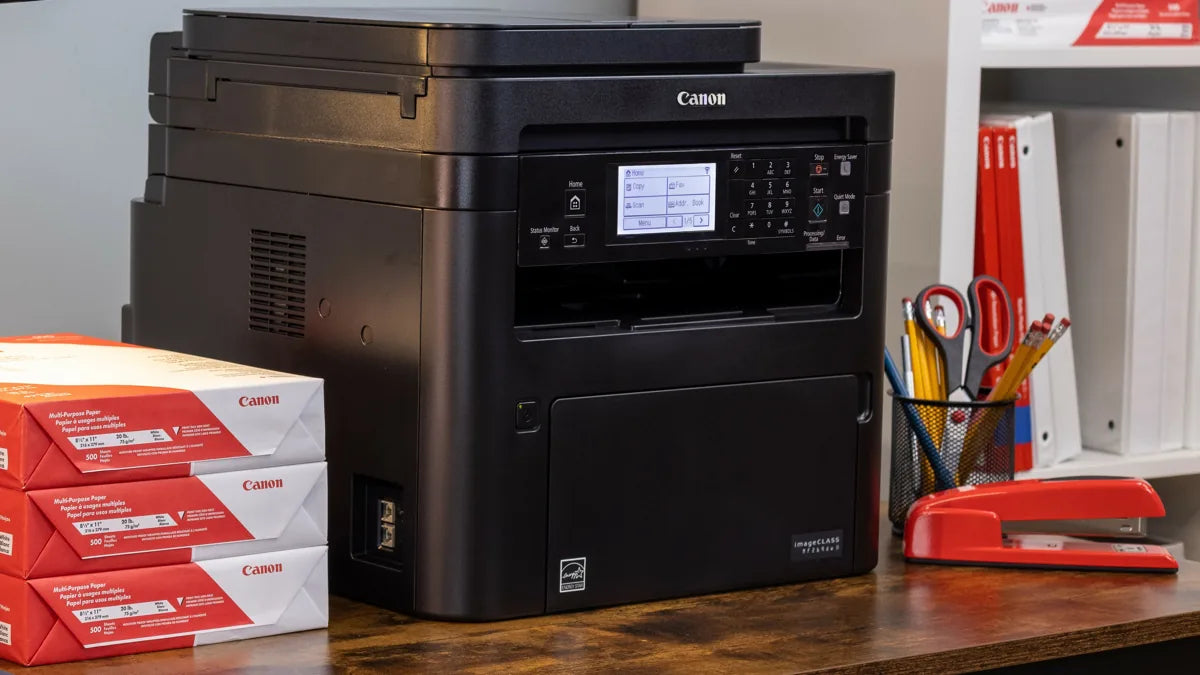This laser AIO knows a thing or two about feeding documents
-
PROS
- Prints, scans, copies, and faxes
- Fast print speed
- 250-sheet paper tray, plus a 1-sheet manual feed
- 50-sheet automatic document feeder
- Automatic duplex (two-sided) printing and scanning
-
CONS
- Duplex scanning uses reversing, rather than single-pass ADF
- Minor settings glitch for printing from Microsoft Word
CANON IMAGECLASS MF269DW II SPECS
| Automatic Document Feeder | |
| Color or Monochrome | Monochrome |
| Connection Type | Ethernet |
| Connection Type | USB |
The Canon imageClass MF269dw II mono laser all-in-one (AIO) printer ($289) is the top-of-the-line model in Canon's MF260 series. It offers the same printing capabilities as the Canon imageClass MF264dw II, making it suitable for light-to-moderate-duty printing in a small office, and adds faxing, like the MF267dw II (which is otherwise identical). It also adds a more talented automatic document feeder (ADF) than either of those models, delivering automatic duplexing (two-sided scanning) and a greater page capacity to let it handle longer documents in bigger bites. Whether you need faxing or not, if you regularly scan or copy duplex documents, the MF269dw II is of obvious interest.
Setting Up the imageClass MF269dw II: A Straightforward Process
The MF269dw II weighs 29.3 pounds and measures 15 by 15.4 by 16 inches (HWD), making it a little too big to share a desk with, though you'll want it nearby for feeding pages into the single-sheet bypass tray when needed. Setup consists of little more than putting it in place and installing the software. Even the toner cartridge and separate drum come already installed, so when you turn on the printer, it's ready to go.
Software installation can be just as easy, as long as you use the included disc. I first tried downloading the software from Canon's website to be sure I had the latest version, but the setup program didn't work, even after a second download to check that the first hadn't dropped a bit or two in the transfer. When I switched to the version on the bundled disc, however, everything went smoothly. I only had to tell the program what connection to use, and it handled everything else automatically. In addition to Ethernet, which I used for my tests, connection options include USB, Wi-Fi, and Wi-Fi Direct. (Canon says it's not aware of a problem with the downloaded version, but it is investigating to see if it can confirm it, and presumably fix it.)

I also ran into a potentially more bothersome setup issue, which I had also seen with the MF264dw II. Even though I had no trouble printing documents from most programs, including Microsoft Excel and PowerPoint, trying to print a Word document gave me a flashing error light on the printer's front panel. As I mentioned in the MF264dw II review, the problem was a mismatch between the paper weight the printer was set for and the setting Word was using, even though other programs were using the same setting as the printer. Canon has since confirmed that it can replicate the problem when installing on a Windows 10 PC and says it's working to fix it.
Having run into the issue before with other Canon models, I decided to take a closer look. It turns out that even when the Canon driver is set to default to 19-to-23-pound paper (what Canon calls Type 2) and the printer is set to the same, Word defaults to the setting for a lighter paper weight (Type 1). To print, you have to either change the setting in the driver every time you launch Word, or go to the printer menu every time the printer shows the error light, and use the control buttons and six-line LCD to change the setting in the printer to Type 1. Another choice is to change the default setting for the driver to Type 1, which Canon says won't make any significant difference to the output. Changing the driver default, along with the setting in the printer menu, let all the business applications in our test suite print without problems.

Paper handling is suitable for light-to-moderate-duty printing in a small office, thanks to a 250-sheet main tray and single-sheet bypass tray. Canon recommends a monthly duty cycle of 250 to 2,500 pages, but a more comfortable maximum—to keep paper refills down to about once a week on average—would be 1,000 pages, or about 50 pages per business day.
Both trays are hidden behind a door that runs across the bottom of the front panel and pivots open from the bottom edge, making it easy to load either tray without having to deal with sliding drawers in and out. Both can accept up to legal-size paper, and both allow automatic duplexing (two-sided printing).

For scanning, the MF269dw II offers a letter-size flatbed and a 50-page reversing ADF, which can scan up to legal-size pages, and can scan both sides of each page by pulling the page through the feeder once to scan one side, then reversing the sheet's direction to pull the page back, turn it over, and scan the second side. Reversing ADFs take more than twice as long to scan both sides of a page as single-pass ADFs with the same speed for single pages, but they also cost less, since they need only one sensor. They're also a big improvement over ADFs that require you to manually reinsert the stack to scan the second side, not to mention ADFs that don't allow even manual duplexing, because they don't come with the software needed to automatically interfile the pages in the right order.
If you print enough to make running costs a significant part of your buying decision, note that the cost per page (CPP) using the MF269dw II's high-capacity toner cartridge works out to 3 cents for toner. The drum is rated for 23,000 pages, which means that once you've printed enough to need a new drum, the cost per page increases to 3.4 cents. As always, keep in mind that the number that matters most is the total cost of ownership, as we discuss in our guide to how to save money on your next printer. The article focuses on inkjets, but the same approach works for lasers.
Testing the MF269dw II: Solid Performance and Output Quality
For our performance tests, I compared the MF269dw II with the MF264dw II; the Lexmark MB2236i, which has a similar list price and a slightly faster speed rating; and the Canon MF455dw, which offers an even faster rated print speed, but is significantly more expensive. Not surprisingly, the overall results for printing text were in line with the rated speeds. The MF455dw was the fastest—by enough to notice for long files—the MB2236i came in second, and the MF269dw II and MF264dw II tied for third place. The latter two Canon printers tied for fastest first-page out (FPO) time, making either of them a touch faster than the MB2236i for one- or two-page files, but by only a second or two.
The results for the rest of the business applications suite were a little surprising. The MB2236i came in last place for every file, which was at least partly due to its slower FPO time and the fact that the files range from just one to three pages long. That said, it was slow enough for those files to come in at a convincing last place overall, despite being faster than the two MF260 series models for text. The MF455dw was easily fastest in the group, while the MF264dw II and MF269dw II were tied for second.
The MF269dw II's text quality in our tests was just short of top tier for a mono laser. Characters offered crisp edges, and all of the fonts we test that would likely be used in business documents were easily readable at 4 points, although not all were well-formed at that size. One of the two highly stylized fonts with heavy strokes was easily readable and well-formed at 8 points. The other, which is harder to render well, was readable at 12 points, but tended to leave too little white space between some characters.

Graphics were close to the same overall level of quality for a mono laser. I saw slight banding, subtle dithering patterns, and uneven pile height in most fills. A single-pixel-wide line on a black background turned into a dashed line, and a wider dark line was so dark it was hard to see. However, most graphics showed what they were meant to show, fine lines on lighter backgrounds held well, and most output was good enough to hand to an important client when you need a report to convey a sense of professionalism. Photos showed many of the same issues, but they were just short of top tier for a mono laser, and easily good enough for printing handouts that include photos.
Verdict: Everything a Small Office Needs, Once You Get It Working
The potential issues with matching paper types can be a headache for getting started with the Canon MF269dw II, but once you sort them out, the printer delivers everything a small office needs in a workhorse mono laser AIO, from suitable paper capacity to the ability to scan in duplex.
Still, if you're sure you'll never need to scan a long duplex document, you might want to consider the MF264dw II or MB2236i instead. Neither supports even manual duplex scanning using an ADF, but the MF264dw II costs less, while the MB2236i offers faster speed for text documents and also adds faxing over the internet, which can be cheaper than the cost of a separate subscription or fax phone line.
At the other extreme, if you scan in duplex so often that you need the speed of single-pass duplex scanning, consider the MF455dw, our top choice for a small-office mono laser AIO. It's more expensive than the MF269dw II, and also a little bigger, but it adds significantly faster speed and higher paper capacity along with the single-pass duplexing ADF. That said, if its extra capability is more in the realm of nice-to-have than essential, the MF269dw II may be just the right fit.


